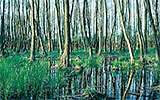Wetlands
The floodplains and wetlands of the Danube basin are uniquely valuable ecosystems in European and even global terms, although few areas are still in their natural or even near-natural state.
According to a study conducted in the framework of the Danube Pollution Reduction Programme, over the last two centuries in particular, most of the larger floodplain areas have disappeared – including up to 80% of the total wetland area along the Danube and its larger tributaries, the Prut, Tisza, Sava, Drava, and Morava.
Did you know?
Primeval riverine forests, which take some 6,000 years to develop, are almost extinct in Europe.
Wetlands are highly productive ecosystems and provide habitats for many species, including endangered ones. They are, however, sensitive ecosystems that can easily suffer from degrading riverbed erosion, pollution, intensive forestry, hunting and intensive recreational use, as well as measures for flood protection, agriculture and navigation.
Besides their ecological value, floodplains can have a considerable positive effect on water quality and nutrient levels. Wetlands also serve as retention areas and help to even out flood peaks and reduce flood damage by storing surplus water.
Facts and figures
The "taming" of wild rivers to improve flood prevention, navigation, agricultural production, and energy production, has shortened the length of the Bavarian Danube by 21% and the length of the River Tisza in Hungary by 31%. Drainage ditches and dykes were built on about 3.7 million hectares of permanently or seasonally inundated land in Hungary during the 19th and 20th century. Some 80% of Romania’s floodplains were likewise drained under agricultural intensification schemes during the 1960s and 1970s.
What the ICPDR is doing
Floodplains in the Danube River Basin were surveyed and evaluated by WWF, as part of the Danube Pollution Reduction Programme, in order to identify the wetlands best suited for restoration. These restoration sites have been included in the Joint Action Programme and in a number of locations rehabilitation measures are being implemented by the Danube Countries (see map: Ecological potential of floodplains in the Danube River Basin).
The status of wetlands and floodplains, their reconnection potential as well as respective measures needed by 2015 are currently investigated in the frame of the development of the Danube River Basin Management Plan (according to the WFD). A final version of this Plan will be available end 2009. However, preliminary findings on wetlands/floodplain can be found in the draft Danube River Basin Management Plan.
The Lower Danube Green Corridor Initiative, a framework for co-operation and co-ordination between the countries of the Lower Danube (Bulgaria, Romania, Moldova and Ukraine), aiming to protect and restore floodplain ecosystems, has been established and is providing support to floodplain conservation and restoration efforts.
As part of this initiative, a World Bank-GEF demonstration project in Bulgaria is focusing on the restoration and sustainable management of thousands of hectares of marsh and wetlands along the Danube – aiming to reduce nutrient levels, improve water quality and protect biodiversity.
Disclaimer
The information contained in the ICPDR website is intended to enhance public access to information about the ICPDR and the Danube River. The information is correct to the best of the knowledge of the ICPDR Secretariat. If errors are brought to our attention we will try to correct them.
The ICPDR, expert group members, nor other parties involved in preparation of information contained on this website cannot, however, be held responsible for the correctness and validity of the data and information provided, nor accept responsibility or liability for damages or losses arising directly or indirectly from the use of the information conveyed therein.
Only those documents clearly marked ICPDR documents reflect the position of the ICPDR.
Any links to other websites are provided for your convenience only. The ICPDR does not accept any responsibility for the accuracy, availability, or appropriateness to the user's purposes, of any information or services on any other website.
When using the information and material provided on this website, credit should be given to the ICPDR.

